
William Becknell made the first recorded trading expedition from Missouri to Santa Fe in 1821. He followed what became known as the "Mountain Branch" of the Santa Fe Trail on his journey westward with oxen- and mule-drawn freight wagons. The crossing of Raton Pass was particularly difficult. Enough so that on his return trip he followed the Cimarron River eastward and avoided the mountain area completely. The "Cimarron Cutoff" wasn't without dangers of its own: lack of water for long stretches and attacks from Utes, Comanches, Apaches, and Kiowas.
In 1826, a 17 year old Christopher "Kit" Carson fled his apprenticeship as a saddlemaker (the man he was apprenticed to offered one penny for his return) in Franklin, Missouri (then the head of the Santa Fe Trail) and joined a caravan headed west. That's how his long career as a frontiersman, explorer, hunter, pioneer, settler, Indian agent and fighter, and military officer began.
In 1833, William Bent built Bent's Old Fort in the Arkansas River Valley between what is now Las Animas and La Junta, Colorado. Traders and mountain men frequented the routes to the fort but most Santa Fe bound travelers stuck to the Cimarron Cutoff and the Mountain Branch saw only intermittent traffic until 1846 when the Army of the West passed through (and destroyed the Bent's Indian trade in passing).
In 1841, after 15 years of the mountaineering life, Kit Carson and his friend, Lucien Maxwell, settled in Taos and both married into prominent Taoseño families. Carson married Josefa Jaramillo and Maxwell married Luz Beaubien, daughter of Charles (Carlos) Beaubien of the Miranda-Beaubien Land Grant and Sangre de Cristo Land Grant fame.
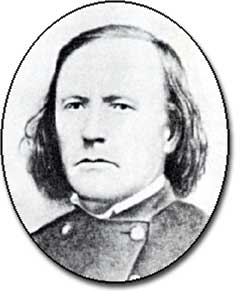
In 1846, Stephen Watts Kearny marched the Army of the West over the Mountain Branch and conquered New Mexico during the Mexican-American War (actually, they never fired a shot because the Mexican government that was in place in Santa Fe ran away). In 1847 the Taos Rebellion broke out and the Carson and Maxwell families barely escaped death. Maxwell's brother-in-law was killed and Maxwell became the heir apparent to the Miranda-Beaubien Land Grant (when Lucien took over it became known as the Maxwell Land Grant) (that's Kit Carson on the right).
The two friends decided to colonize the Grant by building a settlement along the Rayado River where wagons bound for Santa Fe entered New Mexico via the Mountain Branch. Their trading post became one of the principal stops along the Santa Fe Trail (it's now a museum on the Philmont Scout Ranch).
1851 saw the construction and manning of the first Fort Union, just north of what is now Watrous, NM, near where the Cimarron Cutoff and the Mountain Branch came back together for the final push through the canyons, past the remains of Pecos Pueblo and on into Santa Fe.
In 1853, Kit Carson returned to Taos. When the Civil War began he raised the Union flag in Taos Plaza and declared for the Union. He raised a volunteer brigade and became its commanding officer. His recruits fought bravely at the Battle of Valverde but the Confederates eventually won (although the Union troops destroyed their supply train at Cañoncito in Apache Canyon and the rebels high-tailed it back to Texas). About the same time, Lucien Maxwell was moving his trading post 12 miles north and locating on the Cimarron River in the vicinity of present day Cimarron.
In 1860, the United States Army established Fort Wise on the Mountain Branch of the Santa Fe Trail. The next year saw the Postal Service change the mail route from the Cimarron Cutoff to the Mountain Branch.
That same year saw traders from New Mexico bringing supplies over Raton Pass to feed the fledgling city of Denver and all the gold miners passing through. Impressed with the fertile valley of the Purgatoire, 12 families from Mora, New Mexico followed Felipe and Dolores Baca and settled here to begin the settlement that became Trinidad. The Bacas became prominent in town as farmers, ranchers, merchants, and civic leaders. Most of the other families that came with them settled up and down the Purgatoire Valley.
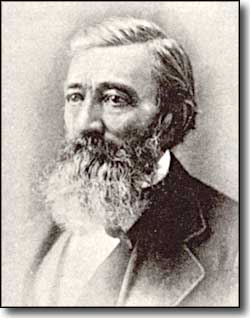
1862 also saw the construction of Fort Francisco in what is now La Veta, in the heart of the "Valley of the Cucharas." The builder of the Fort, John Francisco, was a former suttler with the US Army at Fort Garland in the San Luis Valley. He built the Fort on the main trail leading from the Mountain Branch to the San Luis Valley. Within a couple of years the Fort was the center of a bustling community of farmers and ranchers.
In 1865, former mountain man Richens Lacy "Uncle Dick" Wootton and his partner, George C. McBride, made an agreement with Lucien Maxwell to build a toll road over Raton Pass. They blasted rock, removed road debris and built bridges for months, finally crossing the 27 mile ordeal with a passable road. Then they built a toll booth and charged $1.50 per wagon, 25 cents per horseman and 5 cents per animal from everyone wishing to pass, except Native Americans traveled free (that's George Simpson on the left).
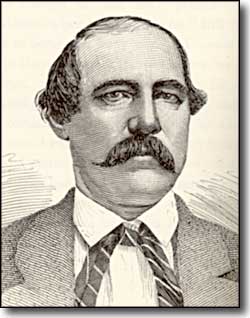
As easy as the toll road made it, Raton Pass was still not a place for the inexperienced. The banks of the road were littered with broken parts of wagons that didn't make it. And sometimes it took up to seven days to complete the crossing (that's Lucien Maxwell on the right).
The end of the Civil War found Kit Carson in failing health. General James Carleton prevailed on him in 1864 to take care of the Navajo and Apache "problem" but the means chosen were an absolute disaster. The tribes were quite elusive so the Army destroyed their crops and animals to force the hungry natives to surrender. Then they force marched 8,000 Indians across 300 miles of New Mexico to Bosque Redondo, a reservation near Fort Sumner. The reservation conditions were brutal and ended in failure a year later. In 1868 Carson escorted a delegation of Ute chiefs to Washington DC for treaty discussions. While there, he consulted with several doctors who told him there was nothing to be done for his medical condition and that he actually might die at any time. He then took the train back to Pueblo and rode in an ox-cart to Boggsville to be with his wife just before she died. He was then taken to Fort Lyons, where he died a few days later.
Westward advancing rail lines in the 1860's and 1870's brought nearly all Trail traffic to the Mountain Branch. Adobe buildings and a few log structures lined Main and Commercial Streets in Trinidad. Town suffered a few raids from the Utes and the chronic lawlessness of a frontier town, but quickly matured into a major center of commerce and agriculture for southern Colorado.
1867 saw the Christmas Day War happen in Trinidad. The weather was very warm for that time of year and the men, having nothing to do after church was over, were going from bar to bar and generally causing a ruckus in town. One particularly obnoxious Anglo was challenging everyone to a boxing or wrestling match. A Hispanic fellow took him up on the offer and immediately pinned the man. Words were exchanged and rocks were thrown. Then Frank Blue, a stagecoach driver for Barlow-Sanderson, walked out of a bar and straight into a thrown rock. He pulled his gun and shot the Hispanic challenger dead. Blue was taken into custody by Sheriff Juan Gutierrez and placed in a vacant building, guarded by 6 Hispanics and 6 Anglos. A few days later he was aided in an escape and his rescuers began firing on every Hispanic in sight. Fire was returned and every Anglo on the street rushed to hole up in P.B. Sherman's hotel on West Main at Beech Street. The sheriff and hundreds of Hispanics took up positions outside the hotel. Then 200 Utes rode into town and offered to assist the sheriff in removing the Anglos from the hotel. The sheriff politely refused so the Utes moved to a hilltop and watched from above. Blue and three companions escaped from the hotel in the middle of the night, taking most of the Anglos' ammunition with them. The next morning a truce was called and the rest of the Anglos were released. Dr. Michael Beshoar took no sides and treated the wounded from both sides. In his opinion "it was a case of bad booze and bad blood."
However, word had been sent to Fort Lyon and Fort Reynolds that a war was going on in Trinidad and military forces were needed to restore peace and order. Martial law was declared and troops were dispatched. En route, the temperature dropped to 26 below zero in a raging blizzard. Acting Governor Frank Hall made a trip to Trinidad to get an eye-witness account of the affair and commented that "Trinidad has the most frontier style of living in the whole of Colorado Territory."
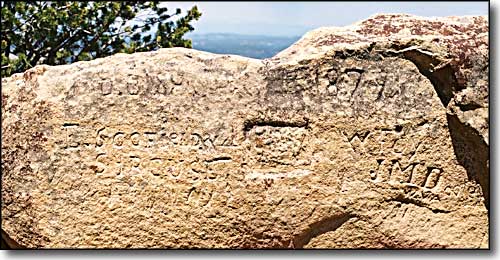
Names and initials from 1871 and before, carved into a sandstone boulder on Soldier's Ridge
One of these is from Lt. John Scoville.
In 1870, John Hough, his wife Mary, and their two daughters moved to Trinidad from the Trail town of Boggsville. His mercantile firm, Prowers & Hough, boasted of carrying the "Largest and best selected Stock of Dry Goods, Groceries, Tobaccos, and Liqnors (sic), in COLORADO TERRITORY." Workers built the family a two story adobe house, using Hispanic construction techniques and English design.
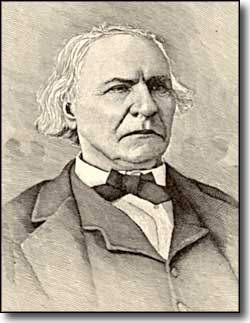
They occupied the house until 1873, when they moved to West Las Animas where the mercantile company had set up a forwarding and commission business at the new railhead. Hough was worried about selling the house but Felipe and Dolores Baca were interested. Together, they negotiated a price of $7,000 worth of wool for the property. For another $1,500 in wool, the Bacas also bought the Hough's furniture. (This is now the Baca House of the Trinidad History Museum.)
1872 saw Cathay Williams settle in Trinidad. Probably no one knew it at the time but she was the first African-American woman documented to have served in the United States Regular Army.
Gold was discovered in the Spanish Peaks area in the early 1870's. It wasn't a big rush and it petered out quickly but by 1876 there were between 50 and 60 mine shafts operating on the twin peaks. At least one was owned and operated by one of Abraham Lincoln's sons.
Trinidad was officially incorporated in 1876, just a few months before Colorado became a state. It was already evolving from a small adobe village into a Victorian jewel. That year about 15,000 tons of freight passed over Uncle Dick's toll road (that's Uncle Dick on the left).
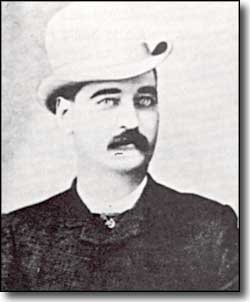
On any given day, up to 500 head of wagon train oxen would be staked out around town, grazing and resting for the journey over Raton Pass. 10,000 sheep (and their shepherds) would spend the day crossing the Purgatoire River in the middle of town. The red light district (on W. Main St., where the Safeway is now) did a booming business with all the cowboys and freightmen passing through.
In 1878, the Atchison, Topeka and Santa Fe Railroad arrived in Trinidad. The next year the train reached Raton and finished the stretch into Santa Fe in 1880.
The railroad also arrived in La Veta in 1878. Part of the north and east walls of Fort Francisco were removed to allow the train to enter and pass through. Shortly thereafter, new money came into town and built a train station a few blocks north of the Fort. The tracks were moved and the center of the community slowly moved north around the station.
The Columbian Hotel, on the corner of Main and Commercial in Trinidad, was built in 1879. (that's Bat Masterson on the right)
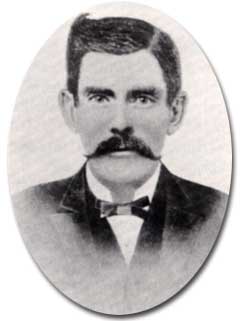
In 1882, merchant, banker and cattle baron Frank Bloom and his wife Sarah built the Victorian jewel in Trinidad that we now know as the Bloom Mansion. Bat Masterson was Town Marshall in 1882 before moving further into Colorado's backcountry. While he was here, though, the Earps and Doc Holliday came into Trinidad, straight from the shootout at the OK Corral. They all holed up for a couple of days with Masterson and sorted out what they needed to do with themselves. The Earps were on their ways pretty quick but Doc had a problem: Arizona wanted to extradite him for murder and try him in Tombstone. So Bat arrested him on a trumped up charge and made a deal with the local judge to never let it come to trial. Arizona couldn't extradite him while this charge was hanging in the air so Doc lived a free life trying the "Colorado Cure" until his tuberculosis killed him five years later in Glenwood Springs (that's Doc on the left).
From its' founding in 1862, Trinidad grew to be 560 citizens in 1870, 2,226 citizens in 1880.
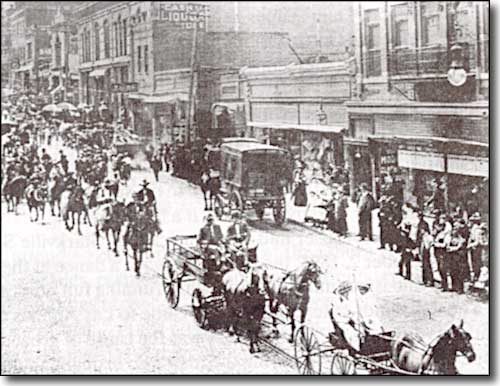
Commercial Street about 1900

